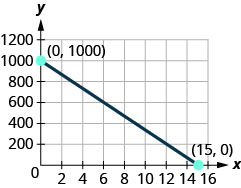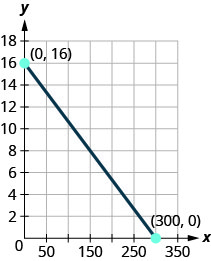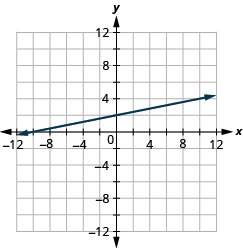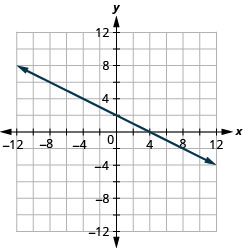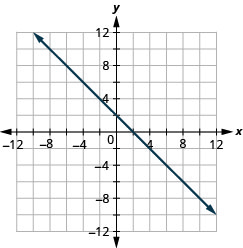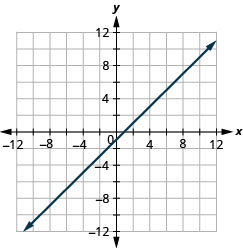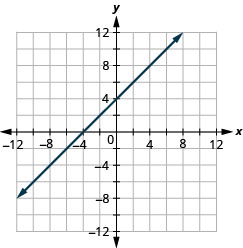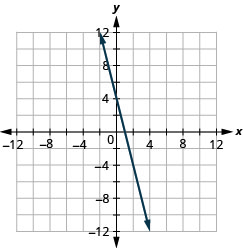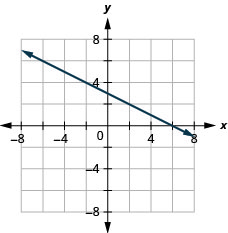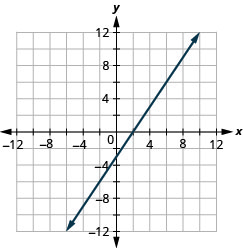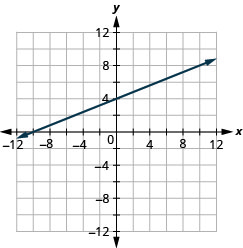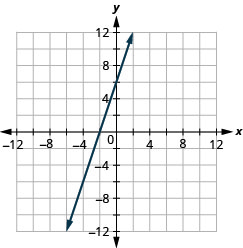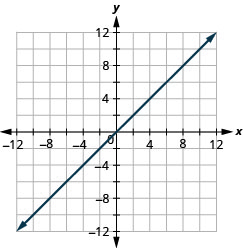CHAPTER 6 Linear Equations and Graphing
6.3 Graph with Intercepts
Learning Objectives
By the end of this section, you will be able to:
- Identify the
 – and
– and  – intercepts on a graph
– intercepts on a graph - Find the
 – and
– and  – intercepts from an equation of a line
– intercepts from an equation of a line - Graph a line using the intercepts
Identify the x– and y– Intercepts on a Graph
Every linear equation can be represented by a unique line that shows all the solutions of the equation. We have seen that when graphing a line by plotting points, you can use any three solutions to graph. This means that two people graphing the line might use different sets of three points.
At first glance, their two lines might not appear to be the same, since they would have different points labeled. But if all the work was done correctly, the lines should be exactly the same. One way to recognize that they are indeed the same line is to look at where the line crosses the x– axis and the y– axis. These points are called the intercepts of the line.
Intercepts of a line
The points where a line crosses the x– axis and the y– axis are called the intercepts of a line.
Let’s look at the graphs of the lines in (Figure 1).
Examples of graphs crossing the x-negative axis.
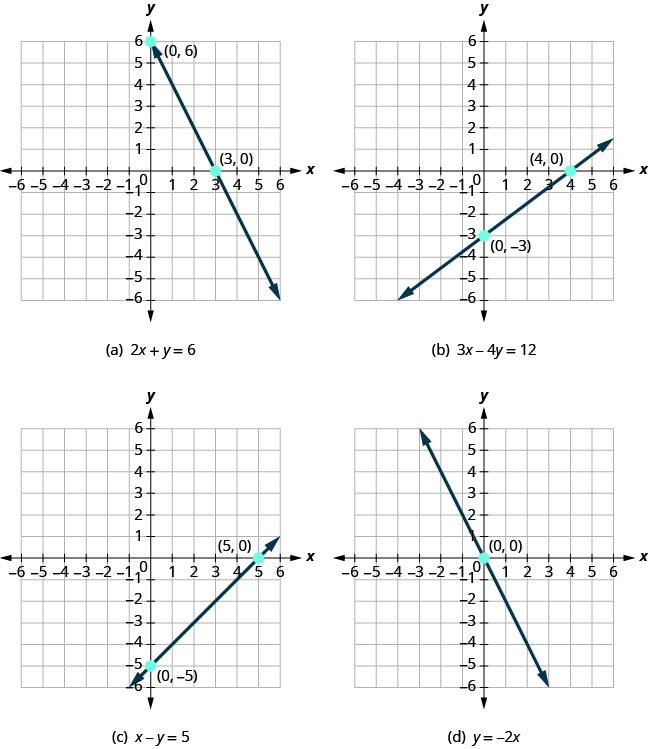
First, notice where each of these lines crosses the ![]() negative axis. See (Figure 1).
negative axis. See (Figure 1).
| Figure | The line crosses the x– axis at: | Ordered pair of this point |
| Figure (a) | 3 | |
| Figure (b) | 4 | |
| Figure (c) | 5 | |
| Figure (d) | 0 |
Do you see a pattern?
For each row, the y– coordinate of the point where the line crosses the x– axis is zero. The point where the line crosses the x– axis has the form ![]() and is called the x– intercept of a line. The x– intercept occurs when
and is called the x– intercept of a line. The x– intercept occurs when ![]() is zero.
is zero.
Now, let’s look at the points where these lines cross the y– axis. See the table below.
| Figure | The line crosses the y-axis at: | Ordered pair for this point |
| Figure (a) | 6 | |
| Figure (b) | ||
| Figure (c) | ||
| Figure (d) | 0 |
What is the pattern here?
In each row, the x– coordinate of the point where the line crosses the y– axis is zero. The point where the line crosses the y– axis has the form ![]() and is called the y- intercept of the line. The y– intercept occurs when
and is called the y- intercept of the line. The y– intercept occurs when ![]() is zero.
is zero.
x– intercept and y– intercept of a line
The x– intercept is the point ![]() where the line crosses the x– axis.
where the line crosses the x– axis.
The y– intercept is the point ![]() where the line crosses the y– axis.
where the line crosses the y– axis.
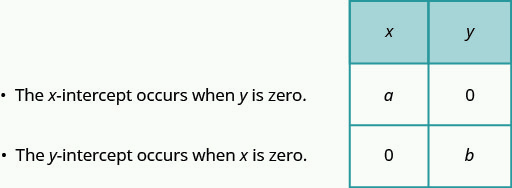
EXAMPLE 1
Find the x– and y– intercepts on each graph.
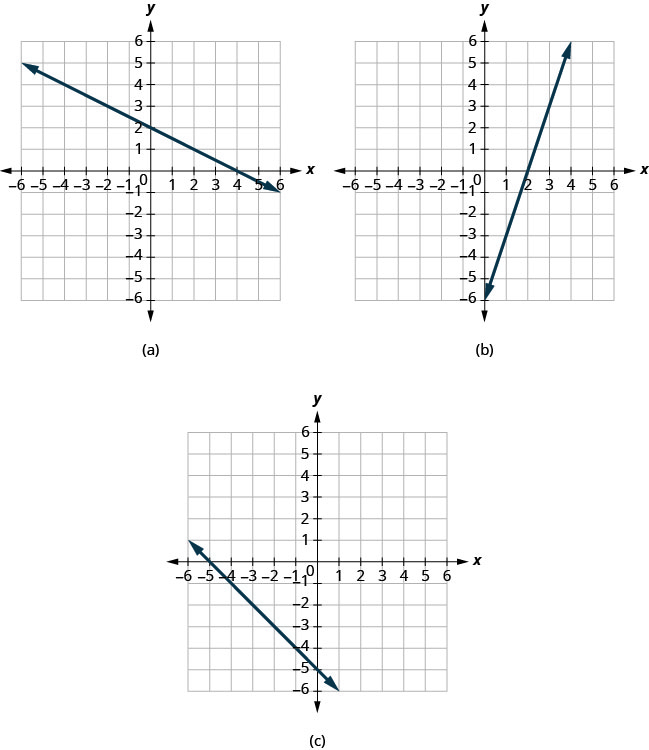
- The graph crosses the x– axis at the point
 . The x– intercept is
. The x– intercept is  .
.
The graph crosses the y– axis at the point . The y– intercept is
. The y– intercept is  .
. - The graph crosses the x– axis at the point
 . The x– intercept is
. The x– intercept is 
The graph crosses the y– axis at the point . The y– intercept is
. The y– intercept is  .
. - The graph crosses the x– axis at the point
 . The x– intercept is
. The x– intercept is  .
.
The graph crosses the y– axis at the point . The y– intercept is
. The y– intercept is  .
.
TRY IT 1.1
Find the x– and y– intercepts on the graph.
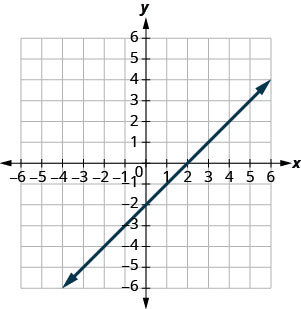
Show answer
x– intercept: ![]() ; y– intercept:
; y– intercept: ![]()
TRY IT 1.2
Find the x– and y– intercepts on the graph.
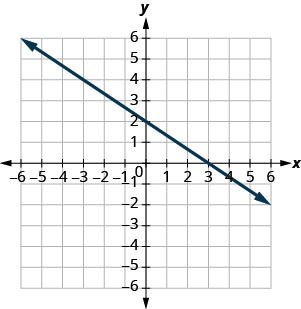
Show answer
x– intercept: ![]() , y– intercept:
, y– intercept: ![]()
Find the x– and y– Intercepts from an Equation of a Line
Recognizing that the x– intercept occurs when y is zero and that the y– intercept occurs when x is zero, gives us a method to find the intercepts of a line from its equation. To find the x– intercept, let ![]() and solve for x. To find the y– intercept, let
and solve for x. To find the y– intercept, let ![]() and solve for y.
and solve for y.
Find the x– and y– intercepts from the equation of a line
Use the equation of the line. To find:
- the x– intercept of the line, let
 and solve for
and solve for  .
. - the y– intercept of the line, let
 and solve for
and solve for  .
.
EXAMPLE 2
Find the intercepts of ![]() .
.
We will let ![]() to find the x– intercept, and let
to find the x– intercept, and let ![]() to find the y– intercept. We will fill in the table, which reminds us of what we need to find.
to find the y– intercept. We will fill in the table, which reminds us of what we need to find.
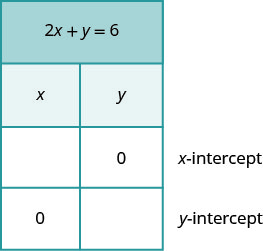
To find the x– intercept, let ![]() .
.
 |
|
| Let y = 0. |  |
| Simplify. |  |
 |
|
| The x-intercept is | (3, 0) |
| To find the y-intercept, let x = 0. | |
 |
|
| Let x = 0. |  |
| Simplify. |  |
 |
|
| The y-intercept is | (0, 6) |
The intercepts are the points ![]() and
and ![]() as shown in the following table.
as shown in the following table.
| 3 | 0 |
| 0 | 6 |
TRY 2.1
Find the intercepts of ![]() .
.
Show answer
x– intercept: ![]() , y– intercept:
, y– intercept: ![]()
TRY IT 2.2
Find the intercepts of ![]() .
.
Show answer
x– intercept: ![]() , y– intercept:
, y– intercept: ![]()
EXAMPLE 3
Find the intercepts of ![]() .
.
| To find the x-intercept, let y = 0. | |
 |
|
| Let y = 0. |  |
| Simplify. |  |
 |
|
 |
|
| The x-intercept is | (3, 0) |
| To find the y-intercept, let x = 0. | |
 |
|
| Let x = 0. |  |
| Simplify. |  |
 |
|
 |
|
| The y-intercept is | (0, −4) |
The intercepts are the points (3, 0) and (0, −4) as shown in the following table.
| 3 | 0 |
| 0 | |
TRY IT 3.1
Find the intercepts of ![]() .
.
Show answer
x– intercept: ![]() , y– intercept:
, y– intercept: ![]()
TRY IT 3.2
Find the intercepts of ![]() .
.
Show answer
x– intercept: ![]() , y– intercept:
, y– intercept: ![]()
Graph a Line Using the Intercepts
To graph a linear equation by plotting points, you need to find three points whose coordinates are solutions to the equation. You can use the x– and y– intercepts as two of your three points. Find the intercepts, and then find a third point to ensure accuracy. Make sure the points line up—then draw the line. This method is often the quickest way to graph a line.
EXAMPLE 4
Graph ![]() using the intercepts.
using the intercepts.
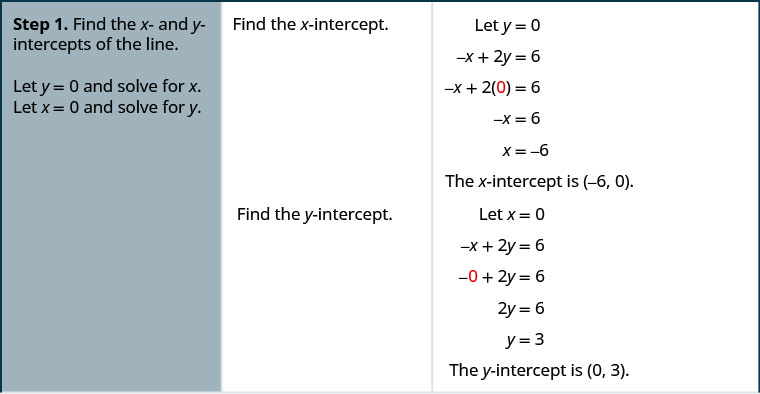

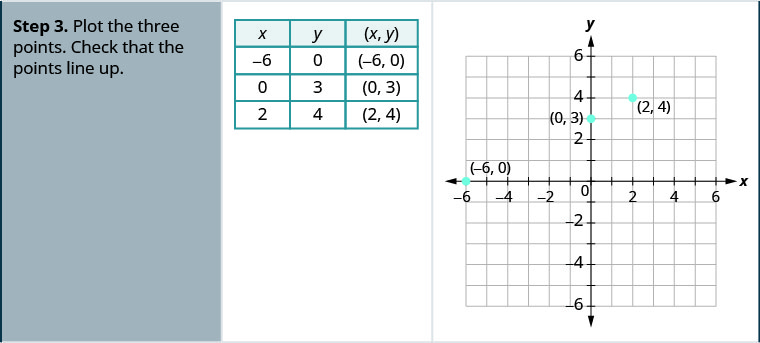
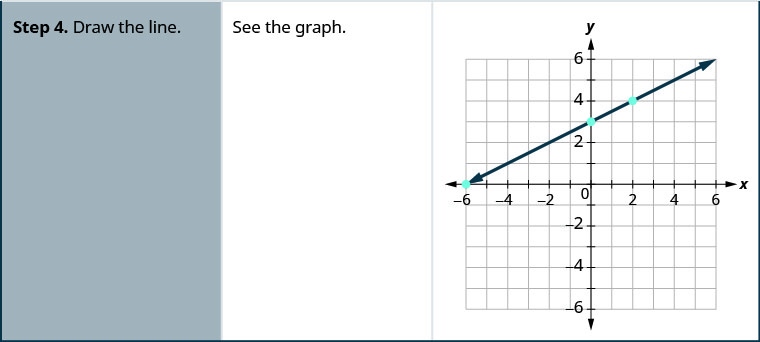
TRY IT 4.1
Graph ![]() using the intercepts.
using the intercepts.
Show answer

TRY IT 4.2
Graph ![]() using the intercepts.
using the intercepts.
Show answer
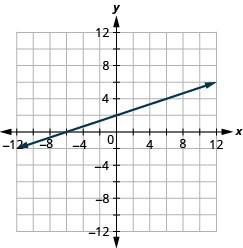
HOW TO: Graph a linear equation using the intercepts
The steps to graph a linear equation using the intercepts are summarized below.
- Find the x– and y– intercepts of the line.
- Let
 and solve for
and solve for 
- Let
 and solve for
and solve for  .
.
- Let
- Find a third solution to the equation.
- Plot the three points and check that they line up.
- Draw the line.
EXAMPLE 5
Graph ![]() using the intercepts.
using the intercepts.
Find the intercepts and a third point.
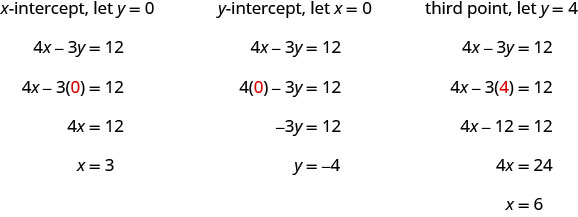
We list the points in following table and show the graph below.
| 3 | 0 | |
| 0 | ||
| 6 | 4 | |
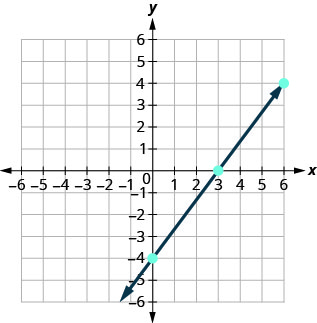
TRY IT 5.1
Graph ![]() using the intercepts.
using the intercepts.
Show answer
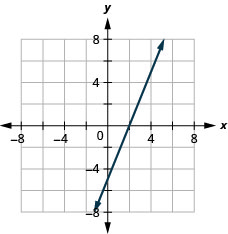
TRY IT 5.2
Graph ![]() using the intercepts.
using the intercepts.
Show answer
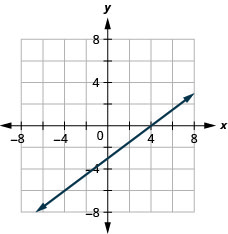
EXAMPLE 6
Graph ![]() using the intercepts.
using the intercepts.
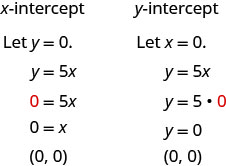
This line has only one intercept. It is the point ![]() .
.
To ensure accuracy we need to plot three points. Since the x– and y– intercepts are the same point, we need two more points to graph the line.
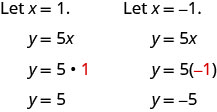
See following table..
| 0 | 0 | |
| 1 | 5 | |
Plot the three points, check that they line up, and draw the line.
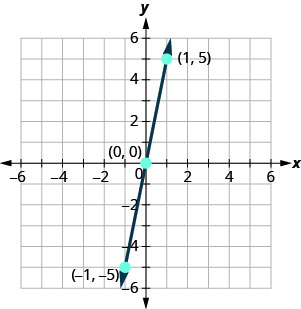
TRY IT 6.1
Graph ![]() using the intercepts.
using the intercepts.
Show answer
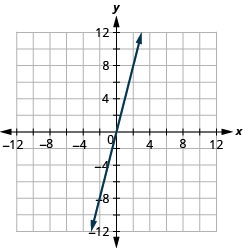
TRY IT 6.2
Graph ![]() the intercepts.
the intercepts.
Show answer
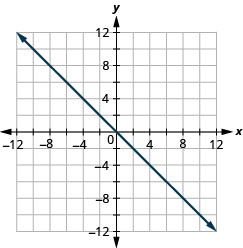
Key Concepts
- Find the x– and y– Intercepts from the Equation of a Line
- Use the equation of the line to find the x– intercept of the line, let
 and solve for x.
and solve for x. - Use the equation of the line to find the y– intercept of the line, let
 and solve for y.
and solve for y.
- Use the equation of the line to find the x– intercept of the line, let
- Graph a Linear Equation using the Intercepts
- Find the x– and y– intercepts of the line.
Let and solve for x.
and solve for x.
Let and solve for y.
and solve for y. - Find a third solution to the equation.
- Plot the three points and then check that they line up.
- Draw the line.
- Find the x– and y– intercepts of the line.
- Strategy for Choosing the Most Convenient Method to Graph a Line:
- Consider the form of the equation.
- If it only has one variable, it is a vertical or horizontal line.
 is a vertical line passing through the x– axis at
is a vertical line passing through the x– axis at 
 is a horizontal line passing through the y– axis at
is a horizontal line passing through the y– axis at  .
. - If y is isolated on one side of the equation, graph by plotting points.
- Choose any three values for x and then solve for the corresponding y– values.
- If the equation is of the form
 , find the intercepts. Find the x– and y– intercepts and then a third point.
, find the intercepts. Find the x– and y– intercepts and then a third point.
Glossary
- intercepts of a line
- The points where a line crosses the x– axis and the y– axis are called the intercepts of the line.
- x– intercept
- The point
 where the line crosses the x– axis; the x– intercept occurs when
where the line crosses the x– axis; the x– intercept occurs when  is zero.
is zero.
- y-intercept
- The point
 where the line crosses the y– axis; the y– intercept occurs when
where the line crosses the y– axis; the y– intercept occurs when  is zero.
is zero.
Practice Makes Perfect
Identify the x– and y– Intercepts on a Graph
In the following exercises, find the x– and y– intercepts on each graph.
|
1.
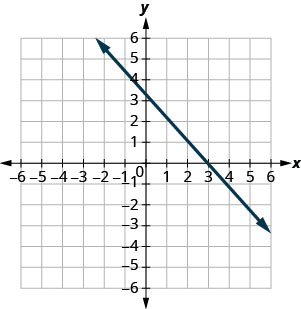 |
2.
 |
|
3.
 |
4. 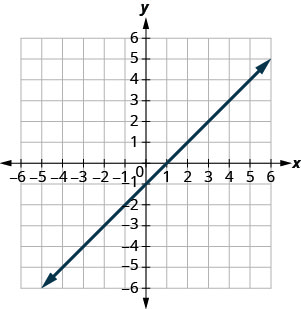 |
|
5.
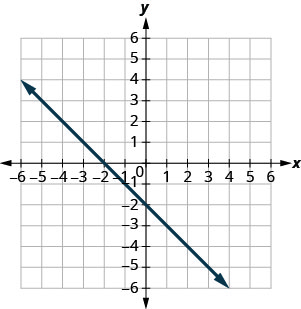 |
6. 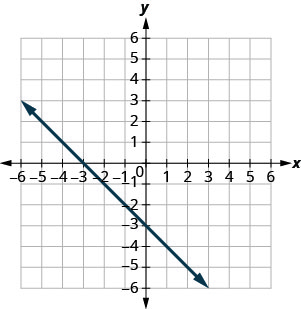 |
|
7.
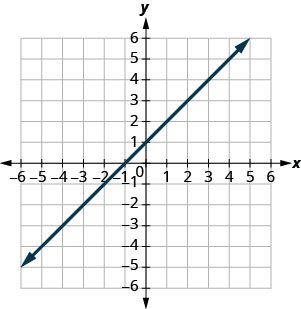 |
8. 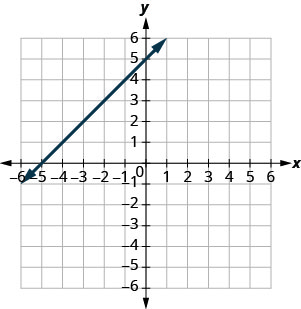 |
|
9.
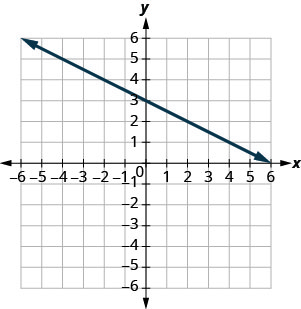 |
10. 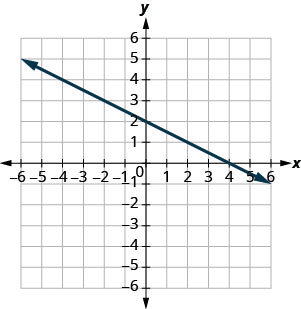 |
|
11.
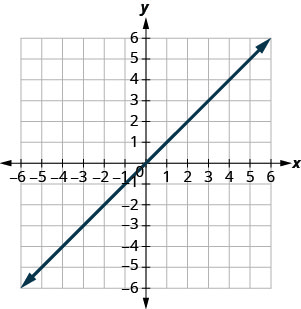 |
12. 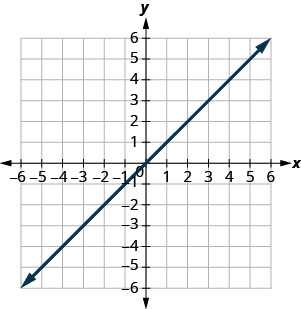 |
Find the x– and y– Intercepts from an Equation of a Line
In the following exercises, find the intercepts for each equation.
| 13. |
14. |
| 15. |
17. |
| 18. |
19. |
| 20. |
21. |
| 22. |
23. |
| 24. |
25. |
| 25. |
27. |
| 28. |
28. |
| 30. |
31. |
| 32. |
33. |
| 34. |
35. |
| 36. |
37. |
| 38. |
39. |
| 40. |
Graph a Line Using the Intercepts
In the following exercises, graph using the intercepts.
| 41. |
42. |
| 43. |
44. |
| 45. |
46. |
| 47. |
48. |
| 49. |
49. |
| 51. |
52. |
| 53. |
54. |
| 55. |
56. |
| 57. |
58. |
| 59. |
60. |
| 61. |
62. |
| 63. |
64. |
| 65. |
66. |
Everyday Math
|
67. Road trip. Damien is driving from Thunder Bay to Montreal, a distance of 1000 miles. The x– axis on the graph below shows the time in hours since Damien left Thunder Bay. The y– axis represents the distance he has left to drive.
|
68. Road trip. Jenna filled up the gas tank of her truck and headed out on a road trip. The x– axis on the graph below shows the number of miles Jenna drove since filling up. The y– axis represents the number of gallons of gas in the truck’s gas tank.
|
Writing Exercises
| 69. How do you find the x– intercept of the graph of |
70. Do you prefer to use the method of plotting points or the method using the intercepts to graph the equation |
| 71. Do you prefer to use the method of plotting points or the method using the intercepts to graph the equation |
72. Do you prefer to use the method of plotting points or the method using the intercepts to graph the equation |
Answers
| 1. |
3. |
| 5. |
7. |
| 9. |
11. |
| 13. |
15. |
| 17. |
19. |
| 21. |
23. |
| 25. |
27. |
| 29. |
31. |
| 33. |
35. |
| 37. |
39. |
| 41.
|
43.
|
| 45.
|
47.
|
| 49.
|
51.
|
| 53.
|
55.
|
| 57.
|
59.
|
| 61.
|
63.
|
| 65.
|
67.
a) |
| 69. Answers will vary. | 71. Answers will vary. |
Attributions
This chapter has been adapted from “Graph with Intercepts” in Elementary Algebra (OpenStax) by Lynn Marecek and MaryAnne Anthony-Smith, which is under a CC BY 4.0 Licence. Adapted by Izabela Mazur. See the Copyright page for more information.

